What Size Is A Piece Of Printer Paper
Paper Sizes and Formats Explained: The Difference Between A4 and Letter of the alphabet
The Difference Between A4 and Letter of the alphabet
Have you always really taken a await at the packs of computer paper you purchase? Or can you automatically middle the standard newspaper used for letters and academic purposes? You have more than likely heard of A5 or Tabloid, but for many, the merely two page sizes that really matter are A4 or Letter. Merely there be a number of paper sizes that are relevant to our everyday lives, and knowing them tin can save you time and coin when printing and copying.
The Systems in Existence
Though other paper size standards exist, at that place are two predominant systems in utilize today. They are the international and North American systems.
Every bit the term implies, the international standard, likewise known as the ISO 216 standard, is used throughout the earth. It is based on an aspect ratio of the square root of 2, like the side of a square and its diagonal. This idea was originally proposed by the German scientist Georg Christoph Lichtenberg in 1786. In 1922, Dr. Walter Porstmann brought Lichtenberg'due south ideas into beingness in Germany. This new standard was known as the DIN 476 standard. The organization became widely used during World State of war II. The almost commonly used ISO newspaper size is A4.
The North American arrangement is used primarily in the USA and Canada. The current sizes are based on traditional sizes such as Letter (eight.5 in × 11 in) and Legal (8.5 in × xiv in). The names of Northward American sizes have started with ANSI e'er since the adoption of ANSI/ASME Y14.ane by the American National Standards Found in 1995. Though the sizes now begin with ANSI, they are however based on the traditional sizes.
Paper Sizes Quick Lookup
Swift Publisher
Desktop Publishing Software for Mac
This slick page layout app provides all you need to create effective desktop publishing materials.
ISO 216
The most convenient and distinguishing characteristic of ISO newspaper is that each format has an aspect ratio equal to the square root of 2 (1:4142) which makes it simple to overstate or reduce a certificate for press on another ISO newspaper format. The most pop series of the ISO standard is the A series. The nearly widely used newspaper of this series is the A4 format. All paper sizes of this series have a proper name that consists of an A followed by a number. The larger that number, the smaller the paper.
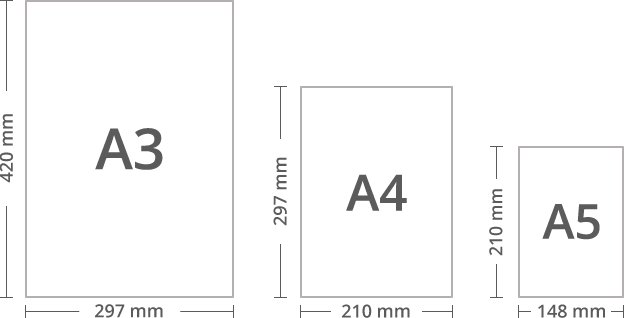
The ground for the whole system is the A0 format which has an area of one square meter. With an aspect ratio equal to the square root of two, a canvass of A0 newspaper ends up existence 841 × 1189 millimeters. Figuring out the dimensions of the subsequent newspaper sizes does not crave any real mathematical strain since each ensuing size can exist created by simply folding the newspaper in one-half with the crease parallel to the shortest sides. If you exercise this with an A0 canvass of newspaper, the resulting dimensions volition be 594 × 841 millimeters, or the A1 format. Accept notation that the height of A1 is equal to the width of A0.
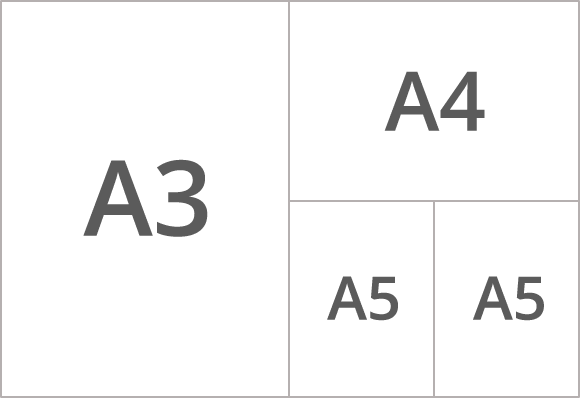
2 other ISO paper serial exist—B and C. The B series was brought into being to provide a wider range of paper sizes, where equally the C serial is used only for envelopes. The B paper sizes are a bit larger than their A series counterparts and are based on the geometric hateful of 2 consecutive A series sheets. For instance, B4 is between A3 and A4 in size, and B5 is betwixt A4 and A5.
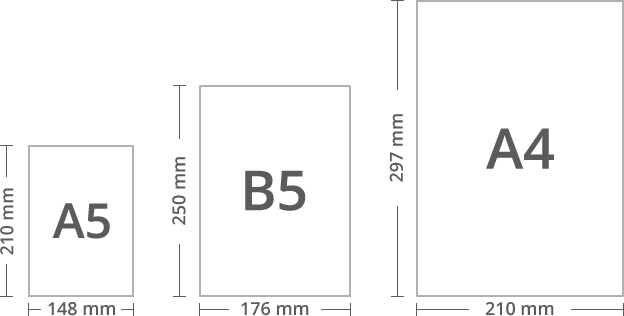
The C series was introduced to provide an envelope with enough space for an A series sail. The sizes of the A series fit in C series envelopes of the same number. That is, a sheet of A4 hands fits into a C4 envelope. The C sizes are but betwixt the A and B series. Beneath are tables with the dimensions of all three serial. All of them have a meridian-to-width ratio equal to the foursquare root of two.
| Format | Size in Millimeters | Size in Inches |
|---|---|---|
| A0 | 841 × 1189 | 33.1 × 46.eight |
| A1 | 594 × 841 | 23.4 × 33.ane |
| A2 | 420 × 594 | 16.five × 23.4 |
| A3 | 297 × 420 | 11.vii × sixteen.5 |
| A4 | 210 × 297 | 8.three × 11.7 |
| A5 | 148 × 210 | five.viii × viii.3 |
| A6 | 105 × 148 | 4.1 × 5.8 |
| A7 | 74 × 105 | ii.ix × iv.1 |
| A8 | 52 × 74 | 2.0 × two.9 |
| A9 | 37 × 52 | ane.v × 2.0 |
| A10 | 26 × 37 | one.0 × 1.5 |
| Format | Size in Millimeters | Size in Inches |
|---|---|---|
| B0 | thousand × 1414 | 39.4 × 55.7 |
| B1 | 707 × one thousand | 27.viii × 39.iv |
| B2 | 500 × 707 | 19.7 × 27.8 |
| B3 | 353 × 500 | 13.9 × xix.7 |
| B4 | 250 × 353 | 9.viii × 13.9 |
| B5 | 176 × 250 | 6.9 × 9.8 |
| B6 | 125 × 176 | 4.9 × 6.nine |
| B7 | 88 × 125 | 3.5 × four.9 |
| B8 | 62 × 88 | 2.4 × 3.5 |
| B9 | 44 × 62 | 1.seven × 2.4 |
| B10 | 31 × 44 | i.2 × ane.7 |
| Format | Size in Millimeters | Size in Inches |
|---|---|---|
| C0 | 917 × 1297 | 36.1 × 51.one |
| C1 | 648 × 917 | 25.5 × 36.1 |
| C2 | 458 × 648 | 18.0 × 25.5 |
| C3 | 324 × 458 | 12.8 × xviii.0 |
| C4 | 229 × 324 | 9.0 × 12.eight |
| C5 | 162 × 229 | 6.4 × 9.0 |
| C6 | 114 × 162 | 4.5 × 6.4 |
| C7 | 81 × 114 | 3.2 × 4.5 |
| C8 | 57 × 81 | 2.ii × 3.two |
| C9 | 40 × 57 | 1.half-dozen × 2.two |
| C10 | 28 × forty | one.1 × 1.6 |
Though these are the main formats of the ISO standard, there are other sizes used for printed items such as labels, business cards, and then on. They are often derived by cutting standard sizes into equal parts. This often leads to sizes with an aspect ratio other than the square root of two.
Height-to-width Aspect Ratio Alternatives
Depending on the project purpose, attribute ratios vary. Standard paper formats can exist presented in the formula of the square root of two, according to the ISO paper size concept. Once non-standard solutions are required, the aforementioned parallel cutting takes place with the only difference existence the number of accomplished parts. As a result, iii, 4 or 8 equal pieces are obtained. Hither are some samples of long sizes.
| Paper Size | Size in Millimeters |
|---|---|
| ⅓ A4 | 99 × 210 |
| ¼ A4 | 74 × 210 |
| ⅛ A4 | 37 × 210 |
| ¼ A3 | 105 × 297 |
There are standard ways to apply this or that sub-standard size format. For instance, 1-third of A4 is preferable for invitations and personal DL envelopes, while ane-quaternary of A4 is a nice option for flyers. Small-sized formats aren't preferable for large volumes of text—it should typically be no more than a simple and brief message.
ISO Tips to Salvage You Time
Simplified Enlargement and Reduction
Many copy machines accept preset magnification factors for enlarging or reducing a copied document in order to print it on a dissimilar paper size. These presets typically take the form of buttons labelled A3→A4 and and so forth. This eliminates wasted margins and saves you the trouble of trying to guess the correct magnification gene, which can lead to a heap of misspent newspaper. Below is a table of the magnification factors between the almost mutual A sizes in case the copiers at your local library do not have such presets.
| A0 | A1 | A2 | A3 | A4 | A5 | A6 | A7 | A8 | A9 | A10 | |
|---|---|---|---|---|---|---|---|---|---|---|---|
| A0 | 100% | 71% | 50% | 35% | 25% | 18% | 12.five% | eight.8% | six.2% | 4.4% | 3.one% |
| A1 | 141% | 100% | 71% | 50% | 35% | 25% | 18% | 12.5% | 8.8% | vi.2% | 4.four% |
| A2 | 200% | 141% | 100% | 71% | l% | 35% | 25% | xviii% | 12.5% | 8.8% | half-dozen.2% |
| A3 | 283% | 200% | 141% | 100% | 71% | fifty% | 35% | 25% | eighteen% | 12.5% | 8.8% |
| A4 | 400% | 283% | 200% | 141% | 100% | 71% | 50% | 35% | 25% | eighteen% | 12.5% |
| A5 | 566% | 400% | 283% | 200% | 141% | 100% | 71% | 50% | 35% | 25% | 18% |
| A6 | 800% | 566% | 400% | 283% | 200% | 141% | 100% | 71% | 50% | 35% | 25% |
| A7 | 1131% | 800% | 566% | 400% | 283% | 200% | 141% | 100% | 71% | 50% | 35% |
| A8 | 1600% | 1131% | 800% | 566% | 400% | 283% | 200% | 141% | 100% | 71% | fifty% |
| A9 | 2263% | 1600% | 1131% | 800% | 566% | 400% | 283% | 200% | 141% | 100% | 71% |
| A10 | 3200% | 2263% | 1600% | 1131% | 800% | 566% | 400% | 283% | 200% | 141% | 100% |
A Fit for Any Envelope
The consistent aspect ratio of the ISO papers makes information technology easy to fit larger newspaper sizes into smaller envelopes. This can be washed by simply folding the larger papers in half (crease parallel to the shorter sides) until you attain the desired size. The divergence in the number of the folio sizes equals the number of times you should fold information technology. So if yous take a C4 or B4 envelope and a sheet of A2 paper, you should fold information technology in half twice. The same method works for filing larger paper sizes in file folders of a smaller size.
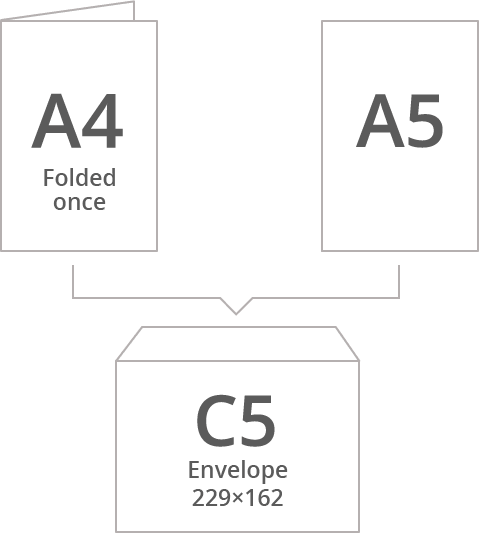
This works with the B and C envelope formats. Another usually used format is the DL format. A DL format envelope volition suit an A4 canvas folded in thirds or an A5 sheet folded in half lengthwise. Read more about common envelope sizes and styles.
North American Sizes
The North American paper sizes are based on traditional formats with arbitrary aspect ratios. The well-nigh pop formats of the traditional sizes are the Alphabetic character (eight.5 × 11 inches), Legal (8.5 × fourteen inches) and Tabloid (xi × 17 inches) formats. Y'all more than than likely use these formats in your everyday life. Letter is the standard for business and academic documents. The Legal format is used to make legal pads, and the Tabloid format is commonly used to make tabloids or smaller sized newspapers. Very piffling is known about the origin of the traditional American paper formats.
| Format | Size in Inches | Size in Millimeters |
|---|---|---|
| Junior Legal | 8 × 5 | 203 × 127 |
| Letter | 8.five × 11 | 216 × 279 |
| Legal | eight.5 × 14 | 216 × 356 |
| Tabloid (Ledger) | 11 × 17 | 279 × 432 |
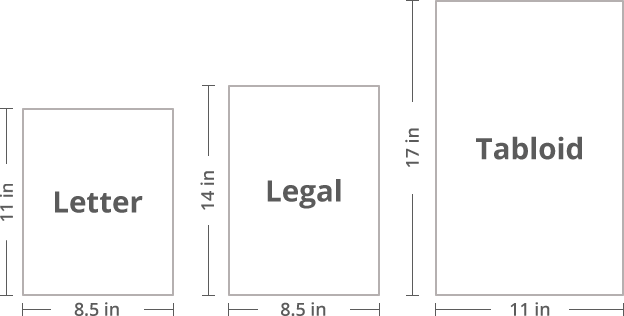
There take been a few attempts to standardize the paper industry in America. President Hoover brought about the Government size when he ordered that all governmental documents and forms be printed on paper with the dimensions of 8 × ten ½ inches. The usage of this format did not detect its fashion to the full general public, and so President Reagan later made the Letter format the standard again.
In 1995, the American National Standards Institute adopted the ANSI/ASME Y14.ane standard. The different formats of this system are denoted by ANSI followed by a letter. Fifty-fifty though this standard exists, the traditional sizes notwithstanding remain the about widely used.
This relatively young standard is based on the traditional Letter format (ANSI A). The Letter format is comparable to the ISO A4 format in equally much every bit it is widely used for concern and academic needs, only the sizes exercise differ.
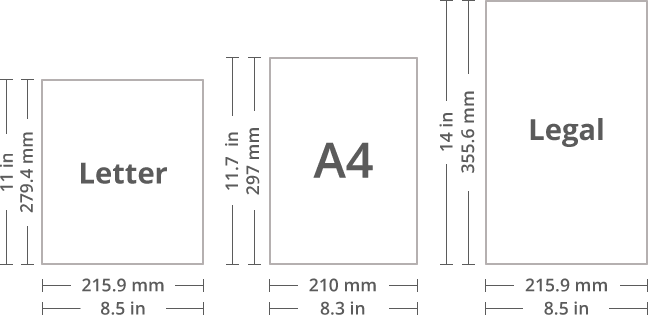
The ANSI paper formats are similar to those of the ISO standard in that cut a sheet in one-half will produce two sheets of the next size. The difference lies in both size and the aspect ratio. The ANSI sizes take an attribute ratio that alternates between 1.2941 and 1.5455. This makes enlarging and reducing a page to fit other ANSI formats hard and less systematic than with the ISO layouts. You will more than likely cease upward with margins differing from the original page.
| Format | Size in Inches | Size in Millimeters | Ratio |
|---|---|---|---|
| ANSI A | viii.v × 11 | 216 × 279 | one.2941 |
| ANSI B | 11 × 17 | 279 × 432 | ane.5455 |
| ANSI C | 17 × 22 | 432 × 559 | i.2941 |
| ANSI D | 22 × 34 | 559 × 864 | ane.5455 |
| ANSI E | 34 × 44 | 864 × 1118 | ane.2941 |
The use of American newspaper sizes often leads to many issues when it comes to the international exchange of documents and therefore has go less common in universities where students are more ofttimes held to international standards when attending conferences or submitting manufactures to international journals. Luckily, documents can exist prepared to be printed on both ANSI and ISO paper formats.
Printing A4 Documents on Letter and Vice Versa
A business partner from Frg has merely sent you a document in the A4 format that yous need to print out. Y'all impress the document and notice that in that location are some parts cutting off at the top and bottom of each page. This is due to the divergence in size betwixt the A4 and Letter (ANSI A) formats. To impress or copy an A4 document on Alphabetic character, you should set up the magnification factor to 94% since the Letter format is 6% less tall than A4. If you plan on printing a Alphabetic character certificate on A4, you should set the magnification factor to 97% since A4 is 3% less broad.
Untrimmed Newspaper Pages
Different trimmed sizes, which are pieces with the final dimensional ratio, untrimmed formats are slightly bigger than the A and B serial. This difference comes in handy for commercial printing, allowing the publishing of big volumes of interconnected pages in the right proportions. At the same time, they are functional tools for rotating printing presses.
There are ii types of untrimmed sizes—raw format A (before long RA) and supplementary raw format A (briefly, SRA). They are adjusted to the last trim afterwards binding. Here is a quick sample: if A4 equals 100%, RA is 5% bigger, and SRA is xv% bigger correspondingly. The "square root of two" rule is also valid, although the dimensions of accepted untrimmed formats are rounded.
| Format | Size in Millimeters |
|---|---|
| RA0 | 860 × 1220 |
| RA1 | 610 × 860 |
| RA2 | 430 × 610 |
| RA3 | 305 × 430 |
| RA4 | 215 × 305 |
| Format | Size in Millimeters |
|---|---|
| SRA0 | 900 × 1280 |
| SRA1 | 640 × 900 |
| SRA2 | 450 × 640 |
| SRA3 | 320 × 450 |
| SRA4 | 225 × 320 |
Something to Remember Almost
Which paper type you use really depends on your physical location. Some people should keep a supply of both ISO and ANSI paper on mitt. Such people include university students and those who do business internationally or frequently send mail service abroad. Many of your local part supply stores conduct both types of paper regardless of the land, but sometimes information technology may require special ordering.
Thanks to Markus Kuhn for his wonderful commodity on newspaper sizes.
What Size Is A Piece Of Printer Paper,
Source: https://www.swiftpublisher.com/useful-articles/paper-sizes-and-formats-explained
Posted by: chaffeeexpon1985.blogspot.com


0 Response to "What Size Is A Piece Of Printer Paper"
Post a Comment